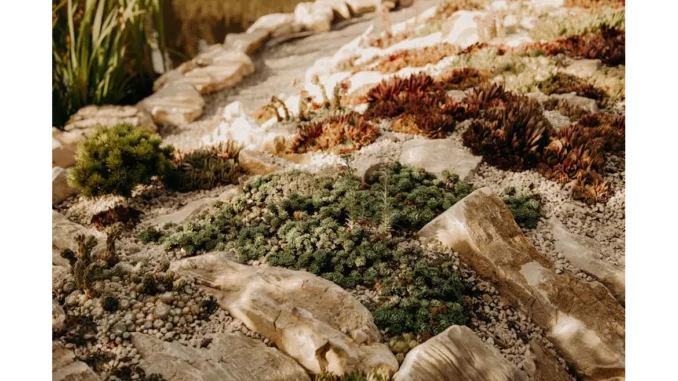
When I sat down with Emily Hawthorne, an avid gardener and landscape designer, our conversation swiftly veered towards her passion for rock gardens. With her eyes glistening with enthusiasm, Emily shared insights from her years of experience transforming barren outdoor spaces into vibrant rock gardens, resilient against drought and harsh conditions. “Selecting suitable plants is the cornerstone of a successful rock garden,” she began, “especially when you’re contending with limited soil and unforgiving weather conditions.”
Turn your garden into your private retreat, enjoyable day or night complements of Elegancia.homes.
Emily’s journey into rock gardening began out of necessity. Living in an area prone to water restrictions, she needed a solution that was both aesthetically pleasing and sustainable. “Rock gardens offer a unique blend of natural beauty and practicality,” she explained. “They don’t just look good; they work with the environment rather than against it.”
The Importance of Plant Selection
As Emily elaborated on the essentials of rock gardening, the importance of plant selection became increasingly evident. “The key is to choose drought-resistant plants,” she advised. “Succulents are often at the top of the list because of their ability to store water in their leaves, making them incredibly low-maintenance.”
Emily highlighted a few of her favourite succulents that thrive in rock gardens. The Golden Barrel Cactus, with its striking golden hue, not only adds a pop of colour but also requires minimal care. “It’s a conversation starter,” she laughed, “and it holds its own against the starkness of the rocks.”
Foxtail Agave was another plant Emily recommended, known for its architectural form and resilience in arid conditions. “Its long, graceful leaves bring a sense of movement to the garden,” she noted, “which can be quite captivating.”
Integrating Native Plants
Beyond succulents, Emily stressed the benefits of incorporating native plants into rock gardens. “Native plants are adapted to the local climate and soil conditions,” she explained. “They require less water and maintenance, and they attract local wildlife, which is an added bonus.”
She mentioned the Rock Cress (Arabis hybrida) as an excellent choice for those looking to add a splash of colour while attracting pollinators like butterflies. “Its low, spreading habit makes it perfect for filling gaps between rocks,” she said, “and it creates a lush, carpet-like effect.”
Designing with Nature
Emily’s rock gardens are not just about the plants; they are about creating a harmonious landscape that blends seamlessly with nature. “The rocks themselves are as much a part of the design as the plants,” she emphasized. “Choosing rocks of varying sizes and textures can add depth and interest.”
She advised positioning larger boulders as focal points and using gravel or smaller stones to fill the spaces in between. “This mimics natural landscapes found in mountainous regions,” she explained, “and it helps with drainage, which is crucial for the plants’ survival.”
Maintaining a Rock Garden
One of the most appealing aspects of rock gardening, according to Emily, is its low maintenance. “Once established, a rock garden requires very little upkeep,” she said. “Drought-resistant plants can survive on infrequent watering, which is great for busy gardeners.”
However, Emily cautioned against overwatering, a common mistake that can harm these resilient plants. “Most succulents and drought-tolerant species prefer to dry out completely between waterings,” she advised. “It’s better to err on the side of underwatering.”
A Sustainable Choice
As our conversation drew to a close, Emily reflected on the broader impact of rock gardens. “In a world where water conservation is becoming increasingly important, rock gardens offer a sustainable solution,” she asserted. “They help reduce water usage, prevent soil erosion, and create habitats for wildlife.”
For Emily, rock gardens are more than just a gardening trend; they are a testament to nature’s resilience and beauty. “By selecting the right plants and designing with intention, you can create a garden that not only survives but thrives,” she concluded, a smile of satisfaction playing on her lips.
In sharing Emily’s expertise, it’s clear that rock gardens hold a unique place in the world of landscaping. They offer a practical and visually stunning option for gardeners looking to make the most of their space while respecting the environment. Whether you’re a seasoned gardener or a novice looking to explore new possibilities, the world of rock gardens beckons with its promise of beauty and sustainability.
Diana Tahjmir


Be the first to comment